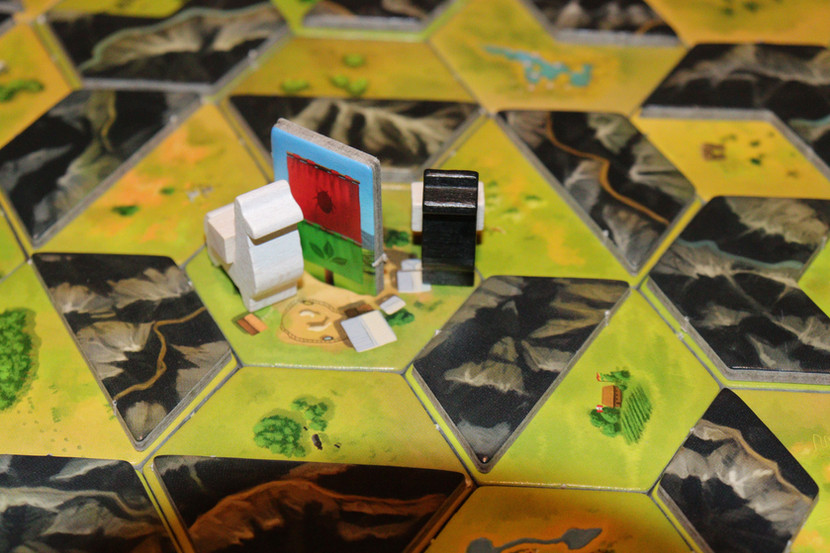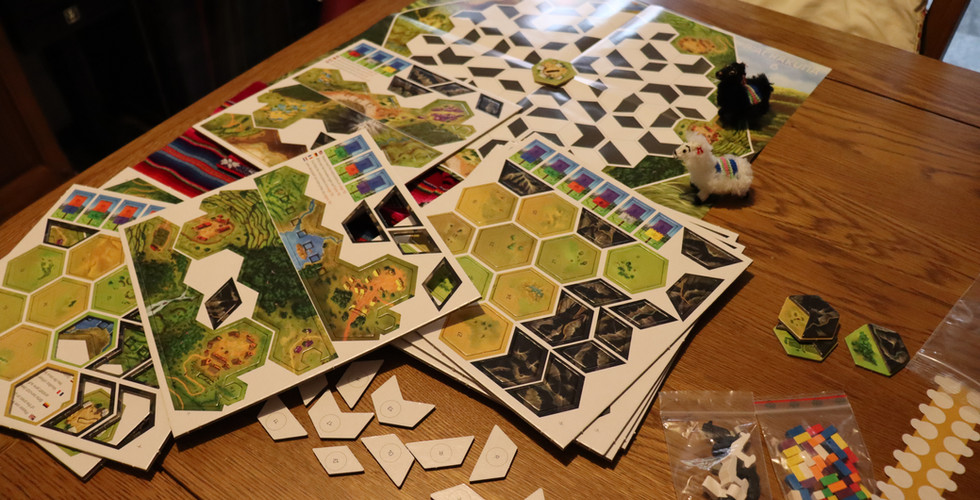Llamas! Let's go to Patagonia and review P'achakuna!
- The Word-nerd

- Nov 12, 2021
- 7 min read
Updated: Jan 15, 2024

Players: 2 Ages: 8+ Game Time: 30-60 Minutes
P'achakuna is a strategic 2-player game by Treeceratops (the print product brand of Treecer GmbH) in collaboration with Suyana, a Swiss NGO fighting against poverty and for sustainable improvement of the quality of lives all over the world. It originally launched on Kickstarter and can now be purchased from the Treecer website.
You are a trader journeying through the heart of the Andes with your best llama pal, collecting and delivering transport bags filled with natural dyes and white wool to Patagonian villages. There is beautiful scenery around you to enjoy, but alas your happy trading travels are not without drama, for a rival trader is trying to outtrade you to be the first to collect all seven yarn colours and create a gloriously colourful traditional costume.
Will you beat your adversary and be the fairest and finest llama handler of them all?
Gameplay
Since Morena Vogel and Stefan Kraft are enlightened species who have clearly learnt much from studying Game Design at the Zurich University of the Arts, their modular game board representing the Andes is made of six frame pieces that form a hexagon with hexagonal terrain tiles in the middle. No spatial suffering from a boring square board, but instead a clever and aesthetically pleasing design that would no doubt make CGP Grey very happy because hexagons are the bestagons!
To start, lock together the frame pieces and assemble the terrain tiles according to the Assembly Plan (Variant A or B), which can be used directly as a base on which to place the tiles. There are 54 terrain tiles in total: 24 neutral tiles, 15 mostly flat tiles, and 15 mostly mountainous tiles.
Then for each village on the frame pieces, draw a demand at random from the cloth bag and slot it into the corresponding cut-out. No demand can ever be the same colour as the village it is placed on and no white demand may be on the board at the beginning of the game. Place the cloth bag and wooden resource markers within easy reach.
Decide between you who will take which colour, black or white. Chose by Rock Paper Scissors Lizard Spock, or a coin flip if there's going to be a fight! Black llamas scale the mountains, whilst white llamas traverse the green valleys. Each player starts with one llama of their colour and places it in the central white village with a white resource on its back, setting the remaining two llamas aside.
White always takes the first turn. To compensate for going second, black starts with one brown resource, which like all resources can be used to buy llamas (four resources) or additional rotations (two resources).
As the game progresses, by rotating the double-layered hexagons, each player builds their very own path and collects coloured resources
A turn consists of four actions:
1. Rotate
A player can complete one free tile rotation (0-360º), terrain tiles occupied by a llama cannot be rotated nor can those that your opponent rotated in the previous turn
Spend two resources for additional rotations
Place a rock on each rotated tile to mark the tiles your opponent cannot rotate in their upcoming turn.
2. Move
Each llama must be moved at least one terrain tile
Llamas can move any number of tiles connected by an uninterrupted path
Each llama must stop in any village it crosses
Multiple llamas can share the same terrain hex.
3. Trade
For every llama that stops in a village, a player can sell resources according to the demand flag at the village or buy llamas.
Sell:
Trade resources according to the following rules:
Resource matches top demand: place the resource in your personal supply and take another resource of the same colour
Resource matches bottom demand: place the resource in your personal supply
Resource matches neither demand: return the resource to the general supply.
If you have not gained that resource before, place it in one of the seven slots in front of you on the board to show that you have collected one of the seven yarn colours.
Buy:
Exchange four resources from your personal supply for a llama, placing it on the village from which it was purchased (a player can own a maximum of three llamas)
Remove the demand marker and set it aside, this is compulsory as you can only trade once per turn in a village.
4. Refill
Refill any missing demands at random from the cloth bag, following the rule that a demand must never be the same colour as the corresponding village (replenish the bag to be able to draw from it should it become empty)
Equip all llamas that have sold their source with a resource matching the village colour.
5. End of the game
The first player to gain each of the seven resources wins the game, for they can make their beautiful and colourful traditional costume and be the most glorious llama handler. Remember it only counts if the resource markers are slotted into your side of the board, those on your llamas still traversing the Patagonian mountains do not count!
Production
The artwork for the box, rulebook and gameboard by Johanna Tarkela is beautiful, with lots of hidden details. The component parts are of excellent quality and visually it is very pleasing and inviting.
The cloth bags are wonderful, not only to look at but also because, thanks to Suyana, these game exclusive items that are made in Bolivia support the Luz De Esperanza foundation, which helps young people in a poor district of El Alta who previously lived on the streets by giving them fairly paid work and a safe home.
Some people will love the fact that after popping out all the cardboard components you get to assemble the double-layered terrain pieces, whilst other people who prefer everything to be pre-assembled may find this frustrating or nerve-wracking. The game does come with little double-sided stickers, so you don't need to have your own glue.
In terms of accessibility, the designers seem to have thought about colour blindness by using symbols on the demand flags, but I don't feel that the whole game in itself is colour blind friendly, as the resource pieces might be hard to distinguish between and each of the villages look pretty much the same. The designers could have done more research to find a more comprehensive solution for greater inclusivity.
The llamas and resource pieces are also quite small and therefore fiddly, so someone with mobility challenges may struggle, and it can be a little tricky to ensure the demand pieces remain upright.
For the Kickstarter fulfilment, there was an issue with some of the frame pieces being too tight meaning that for some backers the terrain tiles either wouldn't all fit or were very difficult to take out for rotation. However, hats off to Treeceratops who quickly acted upon this to provide replacement pieces.
But of course, my favourite part of the Kickstarter was getting two adorable finger puppet llamas, one black and one white.

Nature with all its inhabitants is very important to Treecer, so the P'achakuna game is also 100% carbon neutral. They offset all CO2eq generated during the production and shipping of their products with myclimate, supporting a project in Myanmar that aims to reforest the mangrove forests in the Ayeyarwady Delta, which serves as habitat for many endangered species. The game has minimal plastic, and FSC certified paper/cardboard/wood.
Overall verdict
P'achakuna certainly commands table presence as it is a pretty and colourful game, and the colourful cloth bags that support a charitable organisation are stunning. A game that involves manipulating tiles or resource collection will always go down well with me, and I love that the game uses the best shape in existence (the hexagon). Oh, and it also has llamas!
I love that the rulebook is succinct and easy to follow, with the rules themselves consisting of just three sides of A5. The rulebook also includes educational information on natural dyes and camelids, as well as an overview of Suyana. This is followed by a little bit about Treeceratops, a "Thank You!" page and Terrain Tile Preparation instructions at the rear.
In terms of gameplay, there is a decent amount of replayability as the starting demands will more or less be different every time you play. There is a luck element involved due to drawing the demand tokens randomly, and sometimes this can rinse you whilst your opponent storms ahead. This can mean that it is difficult or sometimes impossible to catch up, which can leave you feeling a little despondent. However, at the end of the day, it's a competitive game so sometimes these things have to be accepted.
Other than the small components, I feel that it is very family-friendly and it is great for exercising/improving spatial awareness but is also great for fully-fledged competitive adults too.
Beyond needing to understand the rules in the first place, P'achakuna is quite language independent. The rulebook also contains a German translation with seven additional languages available for download via the Treecer website.
Overall, P'achakuna is really fun and satisfying to play as you race your opponent to be the first to collect all the resources. Generally speaking, each time you rotate a piece it will have the potential to hinder your opponent as well as helping you. During our playthroughs, the hubby certainly enjoyed making long paths covering big sections of the board with his super spatial awareness and forward planning. You can decide your own balance between friendly but competitive play and play that messes up your opponent's cunning plans with strategic rotations and llama placements (that's where the 0º or 360º rotation can come in!).

For me, P'achakuna is a solid 5 out of 6. It's a beautiful and well-polished game that's easy to learn and play yet strategic and supports a charitable foundation. The components are all of great quality and it's lovely to have a game that is specifically designed for two players. Just a few little niggles short of a masterpiece.
Your Resident Word-nerd Sueyzanne
Box art image taken from the Treecer website
























Great read… looking forward to playing this one!